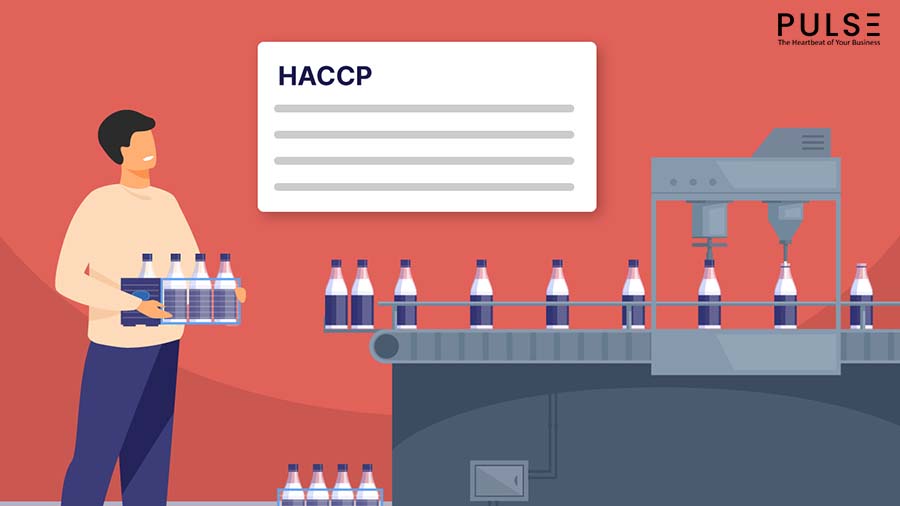HACCP stands for Hazard Analysis Critical Control Points, an internationally recognized safety standard that ensures safe handling, production, and manufacture of food products. HACCP involves identifying risks and assessing food safety hazards to establish a procedural methodology for proactively controlling, measuring, and reducing risk.
Therefore, food manufacturers need to abide by this safety compliance. Let’s see how food processing plants can successfully implement HACCP.
Why is HACCP Relevant to the Food Industry?
According to the FDA: “HACCP is a management system in which food safety is addressed through the analysis and control of biological, chemical, and physical hazards from raw material production, procurement, and handling, to manufacturing, distribution, and consumption of the finished product.”
The key components of controlling preventable and eliminable food safety risks are:
- Hazard analysis identifies the food safety risks, which are later controlled to ensure adherence to safety protocols for producing high-quality deliverable food items. The focal point for hazard analysis lies in evaluating potential sources for microbiological, chemical and physical contamination.
- Critical Control Points refers to essential metrics in a food handling process at production plants on which controls can be applied to prevent or eliminate food safety hazards. The risks can also be effectively monitored by bringing them down to acceptable levels.
The Five-Point Setup of Developing a HACCP Plan
The development of a HACCP involves several procedures before it can be implemented for practical use. In addition, it involves certain steps which are described in detail for reference.
1. Assembling the team
This step involves forming a team that can purely consist of the employees or a hybrid model consisting of consultants and employees. The resources and allocations are decided in this step for further procedures.
2. Describing the products and processes
In this process, the products are analyzed and the management process is evaluated and maintained. In this step, the ingredients temperature, shelf-life and other factors are marked for safe handling.
3. Developing a complete list of materials and ingredients
This step rigorously evaluates the listing of all the ingredients required in preparing the product. All the raw materials and their storage details are duly considered and are marked by the unit for further processing.
4. Developing a flow diagram
A flowchart from the reception of raw materials to the completion of shipment products is prepared. The facility incorporates a proper structuring of the steps involved in creating a system of production which is verified by a walkthrough analysis for confirmation.
5. Ensuring compliance with sanitation protocols
Compliance with hygiene measures is a prerequisite. A draft containing the legalities and Maintenance of standards is crucial for implementing the program.
Implement Successful HACCP in Food Processing Plant in 7 Steps

The seven key components make up for the HACCP framework that ultimately features in the written HACCP Plan.
1. Conducting a Hazard Analysis
Hazard analysis is a procedure in which all processes modulated in a food handling facility are analyzed for their potential to introduce contamination hazards. Hazard analysis consists of two steps.
First, identification of potential hazards is done. Second, the evaluated hazards are evaluated to assess the level of food safety risk they pose.
2. Identifying Critical Control Points
A critical control point (CCP) is an intermediary step where control is deemed necessary to prevent, eliminate, or minimize the risk of a food safety hazard to an acceptable level. In such a system, a decision tree is used to identify CCPs.
The more processing steps carried out in a particular food handling facility are directly proportional to the number of CCPs necessary to monitor the levels of contamination hazards adequately.
3. Establishing Critical limits
A critical limit is the maximum acceptable level of a particular food safety parameter. It indicates an unacceptably high risk to food safety if it crosses the suggested boundaries. Critical limits are expressed in terms of time, temperature, pH, water activity, etc.
4. Monitoring Procedures for critical limits at CCPs
Procedures are established to monitor essential limits at every CCP. The established procedures describe the frequency of monitoring the measurements and the allocation of duty performing or monitoring them, including the methods or devices used.
For instance, if an indicator shows the metal level, the procedures assure the plans to be taken next to bring it down to safe consumption levels.
5. Establishing Corrective actions
Corrective actions refer to the established procedures that must be strictly adhered to if any parameter at a critical control point deviates from the determined critical limits.
The corrective actions prevent the potentially hazardous food from entering the food chain. Disciplinary actions serve to rectify the cause of the hazard, thus preventing the situation from happening again.
6. Verification
This step involves the identification of problems and addressing the issues. Validation is essential to testify and measure product samples by carrying out tests and audit inspections.
7. Recordkeeping
The data collected from safety audits and procedural checking is then maintained and stored in software formats to help tackle emergencies and issues involving overriding food safety protocols.
Auditing and proper record keeping can ensure the maintenance of data and records. Nonetheless, the process can be a little complex due to the diversity of data involved.
Pulse can streamline HACCP compliance for food manufacturers with its agile technology in a state-of-art platform. As a result, auditing, scheduling inspections, assigning tasks, managing workflow, and deriving critical data becomes superfast and easy. For more information, contact us today.
